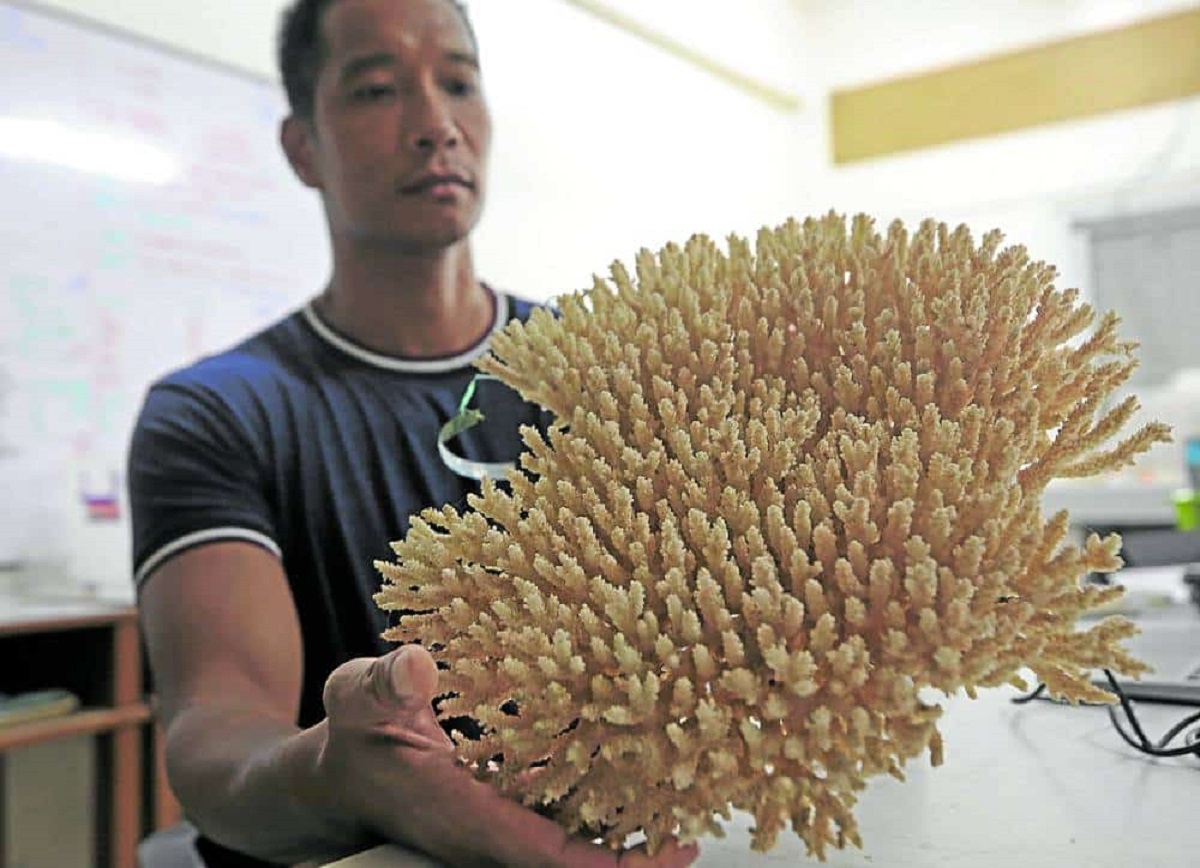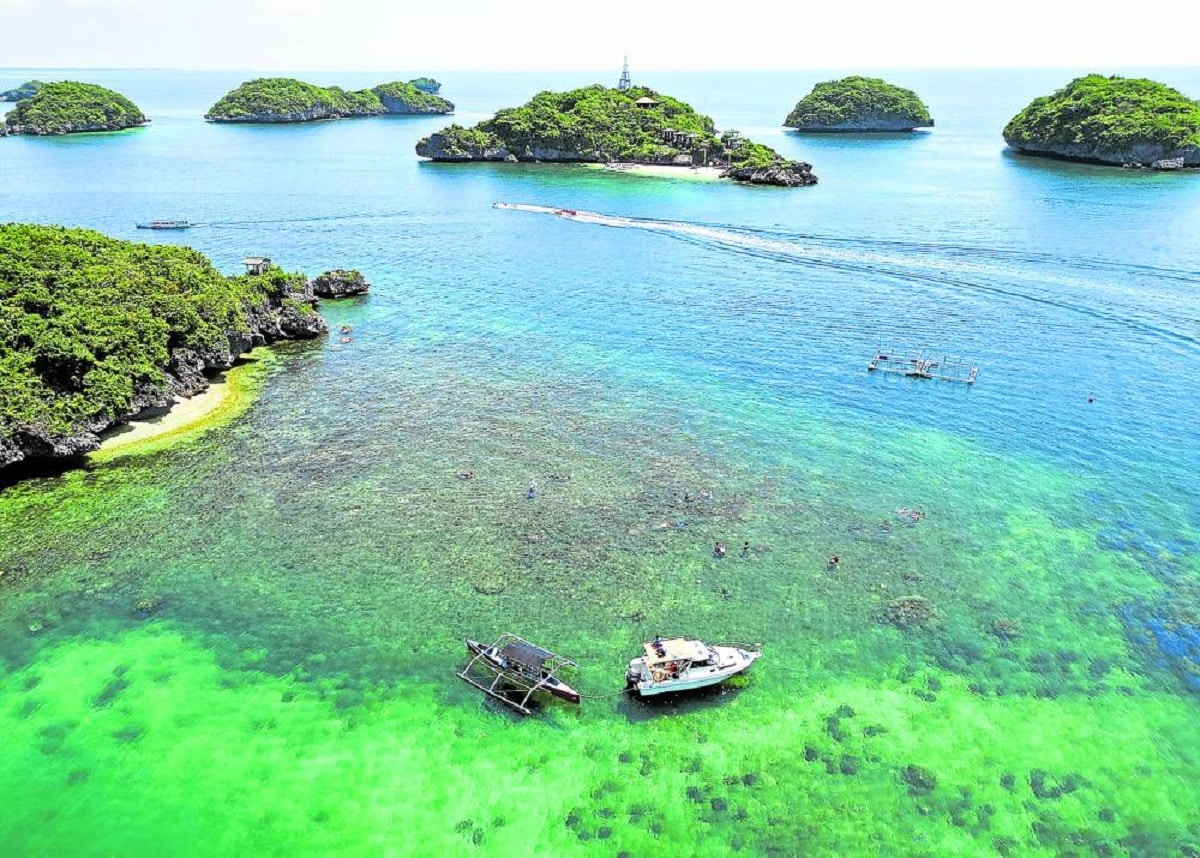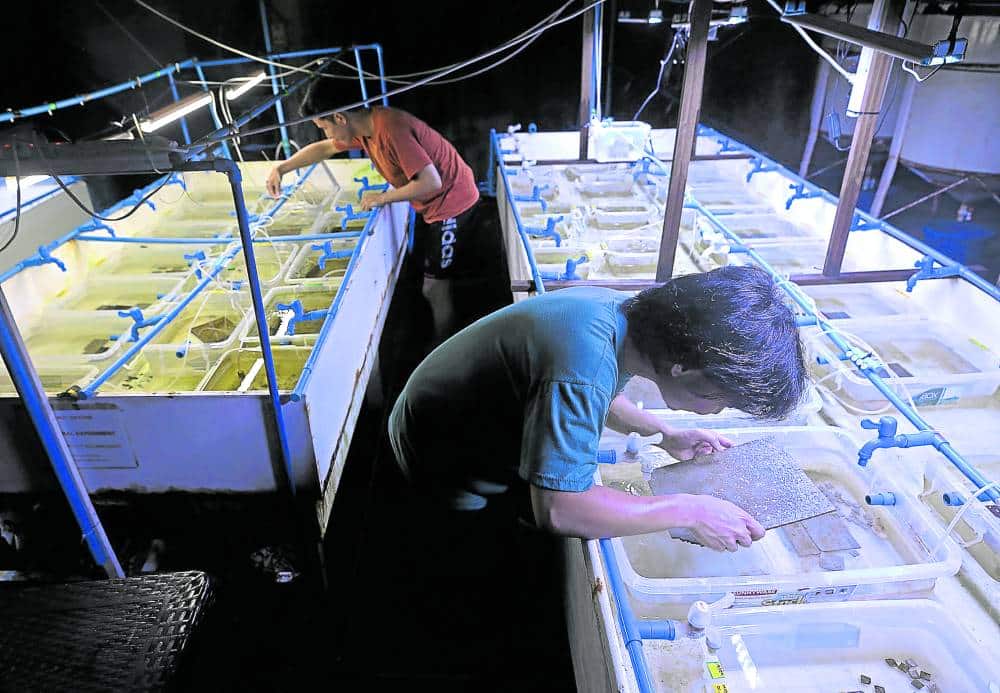PH a living lab in the quest to breed ‘super corals’

MARINE LIFE REVIVAL Marine scientist Dexter dela Cruz shows a sample of the corals that are the focus of a reef restoration project between his team from the University of the Philippines and counterparts from the Southern Cross University in Australia. They have made some progress at the Hundred Islands National Park in Alaminos, Pangasinan, using a method involving coral larvae grown in the lab and later seeded in a target area. —photos by Richard A. Reyes
BOLINAO, PANGASINAN, Philippines — Three years ago, the emerald waters off Quezon Island—one of the 124 islets that make up the famed Hundred Islands National Park in Alaminos City—concealed a vast wasteland of dead corals.
The seabed was basically all rubble, recalled marine scientist Dexter dela Cruz. Very few coral had survived the combined effects of bleaching and the increase in ocean temperatures induced by climate change.
That year, Dela Cruz and his mentor, Australian coral expert Peter Harrison, and a team from the Marine Science Institute of the University of the Philippines (UP-MSI) worked to seed coral larvae on the degraded reefs, hoping to see new life spring from the underwater graveyard.
By 2023, fields of coral covering close to a hectare had grown back, the deathly white expanse replaced by reds and browns.
READ: ‘Ecological disaster’: Escoda Shoal corals may be dead – expert
Article continues after this advertisementIt was a drop in the bucket given the speed and scale in which corals—habitat for some 25 percent of marine species—are dying off across the warming planet. But Dela Cruz and his peers believe the method they employed can help head off catastrophic extinctions.
Article continues after this advertisementWanted: ‘Super corals’
By seeding coral larvae, Dela Cruz said they hoped not only to recover what had been lost but also breed “super corals … that are future-ready,” hardier specimens that can withstand heat waves and other environmental stresses.
And more importantly, they hoped to pass on the technique to fishermen, nature reserve wardens, local governments and other stewards who stand to benefit the most from a thriving marine ecosystem.
“The end product of every research is when people use it … when they use your science and apply it to something good,” he said at a recent media briefing on the seeding project.
“This is my luminous whale,” the 41-year-old said of his goal, finding a metaphor in the mythical sea creature pursued by Nanami and her biologist father in the 1994 anime “Tico and Friends,” which inspired him to be a marine scientist himself.
The UP-MSI, together with Australia’s Southern Cross University (SCU), currently leads an effort in Philippine coral restoration funded by the Australian Centre for International Agricultural Research (ACIAR) since 2012. They have quietly made progress at the Bolinao Marine Laboratory located in Barangay Luciente 1, a village at the mouth of Lingayen Gulf facing the West Philippine Sea.

The area of restoration of damaged reefs using coral larval reseeding in Hundred Islands, Alaminos, Pangasinan. Inquirer photo/Richard A. Reyes
‘Overwhelmed’
The ACIAR research is done in collaboration with Peter Harrison, founding director of SCU’s Marine Ecology Research Centre and Dela Cruz’s supervisor during his doctorate studies.
Often mistaken for plants, corals are animals that also serve as habitat for fish, invertebrates and algae. Under ideal circumstances, they are virtually immortal since they reproduce asexually by cloning themselves.
In the 1980s, Harrison was part of a team that was the first to observe hundreds of coral species in Australia’s Great Barrier Reef (GBR) spawning gametes (sperm and egg) into the sea in synchronous mass spawnings.
Taking a cue from the lunar cycle, the spawnings appear to the naked eye as a colorful blizzard of tiny flecks, which will fertilize and form coral larvae in about five to seven days, before settling back onto the reefs. At least one in a million coral larvae survive long enough to reach sexual maturity in about two to three years.
It’s a small number, “but in nature that works reasonably well,’’ Harrison said at the briefing. “Unfortunately we’re in a global coral crisis; the coral and reef resilience that is naturally present in these systems is being overwhelmed” both by human activity and climate-induced impacts like heat waves and mass bleaching events.
Vulnerable
Triggered by heat stress, bleaching occurs when corals expel the “helpful” algae that live in their tissues, Dela Cruz explained. This expulsion causes them to turn white. It does not always lead to die-offs—sometimes corals reabsorb the algae and survive—but it makes them more vulnerable to disease.
It also makes them susceptible to the effects of climate change and global warming. In 2018, the United Nations scientific panel on climate change projected that an increase in global temperature by just 1.5 degrees Celsius could kill off 70 percent to 90 percent of the world’s corals; a 2-degree increase can all but wipe them out at 99 percent.
As coral losses ultimately deplete fisheries and spell the demise of local marine-based tourism, “we need to think carefully about how to start restoring these reef systems,” said Harrison.
PH as staging area
The Australian expert has pioneered what he described as a form of “coral IVF (in vitro fertilization),” a process that involves capturing and growing coral spawn in a lab until this next generation is ready for seeding in degraded reefs.
It’s cheaper and more genetically diverse, he said, than the most common method—asexual fragmentation—which involves breaking off pieces of coral for transplanting in a target area
Harrison tested the idea—for the first time—in Philippine waters in 2013, working with then Ph.D. candidate Dela Cruz. They had seeded some 400,000 larvae of Acropora tenuis, a near-threatened species of coral, in the waters off Anda, Pangasinan, in an area known as Magsaysay Reef.
After three years, they had established a breeding population, a showcase of the method’s success outside the lab. The Philippines thus became a staging area for further experiments funded by the ACIAR: After Bolinao, Anda and the Hundred Islands, other coral plots were grown in the provinces of Batangas, Palawan and Cebu.
More milestones followed, but also some setbacks. In Mactan, Cebu, a reef they initially identified as a source for coral larvae became a restoration site instead after being damaged by a typhoon in 2020.
Looking forward, Dela Cruz said they also hope to replicate the Philippine accomplishments in the GBR, which hosts the world’s widest array of coral species. For that next level, they need to breed more heat-tolerant corals of different species that can weather bleaching, he added.
Nighttime diving
Until then, there are local feats worth celebrating and sustaining.
The Hundred Islands, for example, was an easy choice for the project. Though it was the first geographical feature in the country to be declared a natural park, its reefs had been suffering from destructive blast fishing since the 1980s, aside from naturally occurring threats like the spread of crown-of-thorns starfish.
The Alaminos municipal government imposes a decades-old fishing ban in the park, but Mayor Bryan Celeste said it remained a struggle to “restore it to its former glory.”
“Having corals there—if managed properly—can be a good tourism investment,” Celeste said.
Off Quezon Island, which remains closed to tourists, Dela Cruz and his team released over 18 million coral larvae of different species in 2018 and again in 2020. They got local residents involved—particularly the “Bantay Dagat” or reserve wardens—who hopefully could do the highly technical procedure on their own in the future.
The task requires some basic knowledge of coral taxonomy and physiology. The spawning process itself is not as easy as it sounds: reviving the reefs this way entails multiple nighttime dives, and covering vast areas could take several days or even weeks.
“You have to take stock of their (local stakeholders’) capacity. Adjust and create a menu that is suitable for them,” Dela Cruz said.
Last year, the fully grown corals in Quezon Island had matured enough to be a source of larvae. Small unhealed patches of previous bleaching remained, but overall “we saw the ecosystem becoming lively again,’’ Mayor Celeste said.
“We’ve seen a lot of big fish [species] that have started to come back.”
Still, Dela Cruz said, “there is no silver bullet, no ‘No. 1’ method that can solve the problem [of coral degradation]. We cannot fully restore all degraded corals. But if we can mitigate the losses, then that’s a step in the right direction.”
